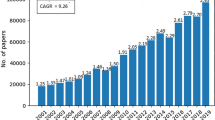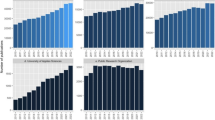Abstract
Motivated by the merging of four Swedish counties to a larger administrative and political unit with increased responsibilities, a comprehensive study of regional–foreign research collaboration was carried out. Various multivariate methods were applied for the depiction of collaborative networks of various compositions and at various levels of aggregation. Other aspects investigated concerned the influence of institutions and countries on regional–foreign collaboration and the relation between collaboration and research fields. Findings showed that foreign research collaboration was concentrated to three major regional institutions, each with a characteristic collaborative context. The influence of domestic collaboration was notable with regard to medical research while collaboration within the field of physics and astronomy was characteristic for pure regional–foreign collaboration, which was the dominating type of research collaboration throughout the period of observation (1998–2006).











Similar content being viewed by others
Notes
The adjusted CWTS hierarchical field classification system is available at the author’s Website (Jarneving 2009).
For instance the Jaccard index or Salton’s cosine formula which both normalize for size.
A value near zero is arrived at if one or both of u ik and v jk is near zero on dimension k.
The selection of k dimensions is done in relation to the distribution of inertia (variation) so that k dimensions cover most of it.
The Gini index is the Gini coefficient expressed as a percentage.
I.e. a unique occurrence of an institutional address in a publication equals one publication produced by the same institution.
Nine co-occurrences—corresponding to one annual paper on the average during the period of observation—were applied as a preliminary cut off point and lower frequencies regarded random. In this distribution, the Gini Index was 22%.
Some of the more interesting findings are presented here, but for a detailed study of the map, complementary data is available at the author’s Website (Jarneving 2009).
As a matter of clarity, we denote the total network made up by all collaborative associations between all types of institutions (regional, domestic, foreign) the “regional-foreign” network.
The term”unique” is used to mark that the co-occurrence frequency of two institutions is based on the number of publications in which two institutions occurred in the same address field—not the factual occurrence of their institutional addresses. The threshold of 30 corresponds to a level above the 99th percentile in the total distribution of collaboration links.
Spanish National Research Council (CSIC) is the largest public research organisation in Spain whereas European Organization for Nuclear Research (CERN) is the largest particle physics laboratory of the world. Russian Academy of Sciences collects a large number of scientific research institutes from across the Russian Federation.
Complementary data is available at the author’s Website (Jarneving 2009).
It should be noted that ambiguity is introduced when an alphabetical order is applied as it may either reflect a custom or that all contributions are equal.
The points in the plot are scaled so that row or column points with large marginal frequencies do not dominate.
References
Bartholomew, D. J., Steele, F., Moustaki, I., & Galbraith, J. I. (2002). The analysis and interpretation of multivariate data for social scientists. Boca Raton: Chapman & Hall/CRC.
Cole, J. R., & Cole, S. (1973). Social stratification in science. Chicago & London: The University of Chicago Press.
Egghe, L., & Rousseau, R. (2000). Methods for accrediting publications to authors or countries: Consequences for evaluation studies. Journal of the American Society for Information Science, 51(2), 145–157.
European Commission (2003). Third European Report on Science & Technology Indicators. Appendix: Extended technical annex to chapter 5.
Everitt, B., Landau, S., & Leese, M. (2001). Cluster analysis (4th ed.). London: Arnold.
Gauffriau, M., Olesen Larsen, P., Maye, I., Roulin-Perriard, A., & Von Ins, M. (2007). Publication, cooperation and productivity measures in scientific research. Scientometrics, 73(2), 175–214.
Glänzel, W. (2000). Science in Scandinavia: A bibliometric approach. Scientometrics, 48(2), 121–150.
Glänzel, W., & Schubert, A. (2004). Analyzing scientific networks through co-authorship. In H. F. Moed, W. Glänzel, & U. Schmoch (Eds.), Handbook of quantitative science and technology research (pp. 257–276). Dordrecht: Kluwer Academic Publishers.
Glänzel, W., Schubert, A., & Czerwon, H. J. (1999). An item-by-item subject classification of papers published in multidisciplinary and general journals using reference analysis. Scientometrics, 44(3), 427–439.
Gómes, I., Fernández, M. T., & Méndez, A. (1995). Collaboration patterns of Spanish scientific publications in different research areas and disciplines. In 5th International Conference of the International Society for Scientometrics and Informetrics, River Forest, Illinois, USA.
Hallin, G. (2005). Sektor möter region – men hur och var? En studie av territorium och funktion i svensk politik på uppdrag av Ansvarskommittén. ITPS underlagsrapport till Ansvarskommittén, 2005. Institutet för tillväxtpolitiska studier.www.sou.gov.se/ansvar/pdf/Geografisk%20logik%20ITPS.pdf.
Hicks, D., & Katz, J. S. (1996). Science policy for a highly collaborative science system. Science and Public Policy, 23(1), 39–44.
Jarneving, B. (2009). Homepage. University of Borås. www.adm.hb.se/~boj/Regional%20Research%20and%20Foreign%20Collaboration.pdf.
Luukkonen, T., Tijssen, R. J. W., Pesrsson, O., & Sivertsen, G. (1993). The measurement of international scientific collaboration. Scientometrics, 28(1), 15–36.
Melin, G., & Persson, O. (1998). Hotel cosmopolitan: A bibliometric study of collaboration at some European universities. Journal of the American Society for Information Science, 49(1), 43–48.
Näringsdepartementet (2007). En nationell strategi för regional konkurrenskraft, entrepenörskap och sysselsättning 2007–2013. http://www.regeringen.se/sb/d/6319/a/74835.
Otte, E., & Rousseau, R. (2002). Social network analysis: A powerful strategy, also for the information sciences. Journal of Information Science, 28(6), 441–453.
Regional Council (2005). Vision Västra Götaland: A good life. Region Västra Götaland. http://www.vgregion.se/upload/Regionkanslierna/regionutveckling/RUSEN/vision%20eng%20pdf.pdf.
Rousseau, R. (2000). Concentration and evenness measures as macro-level scientometric indicators. In The second international seminar on quantitative evaluation of research performance. Shanghai, 23–25 October, 2000.
Rousseau, R., & Van Hecke, P. (1999). Measuring biodiversity. Acta Biotheoretica, 47, 1–5.
Schubert, A., & Glänzel, W. (2006). Cross-national preference in co-authorship, references and citations. Scientometrics, 69(2), 409–428.
Trueba, F. J., & Guerrero, H. (2004). A robust formula to credit authors for their publications. Scientometrics, 60(2), 181–204.
Västra Götalandsregionen (2008). Innovationssystemet i Västra Götaland: en analys av utbud och efterfrågan. Rapport tillväxt och utveckling, 2008:02. http://cf.vgregion.se/fakta/trycksak/trycksakPDF/VGISrapport0805199.pdf.
Wagner, C. S., & Leydesdorff, L. (2005). Network structure, self-organization, and the growth of international collaboration in science. Research Policy, 34, 1608–1618.
Wishart, D. (2006). ClustanGraphics Primer: A guide to cluster analysis. Edinburgh: Clustan Limited.
Zitt, M., Bassecoulard, E., & Okubo, Y. (2000). Shadows of the past in international cooperation: collaboration profiles of the top five producers of science. Scientometrics, 47(3), 627–657.
Author information
Authors and Affiliations
Corresponding author
Rights and permissions
About this article
Cite this article
Jarneving, B. Regional research and foreign collaboration. Scientometrics 83, 295–320 (2010). https://doi.org/10.1007/s11192-009-0064-4
Received:
Accepted:
Published:
Issue Date:
DOI: https://doi.org/10.1007/s11192-009-0064-4




